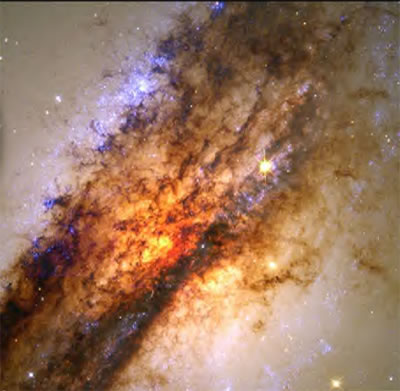
Centaurus
Astronomers have obtained an unprecedented look at the nearest example of galactic cannibalism — a massive black hole hidden at the center of a nearby giant galaxy that is feeding on a smaller galaxy in a spectacular collision. Such fireworks were common in the early universe, as galaxies formed and evolved, but are rare today.
The Hubble telescope offers a stunning unprecedented close-up view of a turbulent firestorm of star birth along a nearly edge-on dust disk girdling Centaurus A, the nearest active galaxy to Earth. The picture at upper left shows the entire galaxy. The blue outline represents Hubble's field of view. The larger, central picture is Hubble's close-up view of the galaxy. Brilliant clusters of young blue stars lie along the edge of the dark dust lane. Outside the rift the sky is filled with the soft hazy glow of the galaxy's much older resident population of red giant and red dwarf stars.
Photographs and astronomical descriptions courtesy of NASA and AURA/STScI
Tales of the Immortal Night ©2003, J.J. Kuhl
Website designed by Business eSolutions Contact them at info@business-esolutions.com